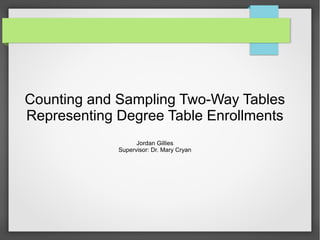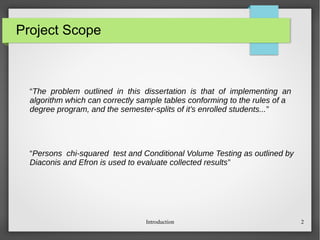This document describes adapting a folklore algorithm for counting and sampling binary contingency tables to sample student enrollment data while satisfying degree program rules and semester balances. It discusses representing enrollment data as two-way tables, implementing the folklore algorithm components, and modifying it to first split tables into semester sub-tables to preserve balances, and then introduce compressed partial row sums to represent class selection rules. The adapted algorithm is applied to sample data for two example degree programs, and conditional value testing is proposed to evaluate results.









![Implementng A Folklore Algorithm 10
PRS and Dynamic Counting
Where c[k] is the column set (c1
, …, ck
)](https://image.slidesharecdn.com/d19b3dfb-aa5a-427a-b187-4f820be6cf31-160622185708/85/FinalPres-10-320.jpg)
![Implementng A Folklore Algorithm 11
PRS and Dynamic Counting
● This allows us to define a dynamic counting algorithm in
which we can compute N(p', c[k+1]) from N(p, c[k]) and
iteratively increase k until N(r,c) is computed.
● For each partial row sum p in Pk
, we will compute how
many ways we can decompose the column value ck+1
across the m rows. This creates the new set of PRS Pk+1
.
Once Pn
is computed, we will have N(r,c).](https://image.slidesharecdn.com/d19b3dfb-aa5a-427a-b187-4f820be6cf31-160622185708/85/FinalPres-11-320.jpg)

![Implementng A Folklore Algorithm 13
Hash Structure
● In order to store the induced compressed partial row sums
for each column we decompose, we will make use of a
Hash Structure.
● Entries have format (k, H(p'), v), in which k represents the
current column, H(p') represents a Hashed value used to
look-up a compressed PRS p', and v representing the total
number of binary contingency matrices so far with
compressed PRS p' and column sums c[k] – N(p',c[k]).](https://image.slidesharecdn.com/d19b3dfb-aa5a-427a-b187-4f820be6cf31-160622185708/85/FinalPres-13-320.jpg)

![Implementng A Folklore Algorithm 15
Counting Algorithm
Over all possible tables (p_k, c[k])](https://image.slidesharecdn.com/d19b3dfb-aa5a-427a-b187-4f820be6cf31-160622185708/85/FinalPres-15-320.jpg)


![Implementng A Folklore Algorithm 18
Counting Algorithm
Calculate every possible way we
can add 1s to the table represented
by p', and for each:
Calculate N(p*, c[k+1])
That is :- x *](https://image.slidesharecdn.com/d19b3dfb-aa5a-427a-b187-4f820be6cf31-160622185708/85/FinalPres-18-320.jpg)
![Implementng A Folklore Algorithm 19
Counting Algorithm
Calculate every possible way we
can add 1s to the table represented
by p', and for each:
Update count if already
added p* to index [k+1],
else create a new entry](https://image.slidesharecdn.com/d19b3dfb-aa5a-427a-b187-4f820be6cf31-160622185708/85/FinalPres-19-320.jpg)
![Implementng A Folklore Algorithm 20
Sampling Algorithm
Starting from
Hash Table[n]:](https://image.slidesharecdn.com/d19b3dfb-aa5a-427a-b187-4f820be6cf31-160622185708/85/FinalPres-20-320.jpg)
![Implementng A Folklore Algorithm 21
Sampling Algorithm
Starting from
Hash Table[n]:
Select a CPRS induced
on the column set c[k-1]
based on how many
tables it contributes to
the count of root. Store
the associated
decomposition.](https://image.slidesharecdn.com/d19b3dfb-aa5a-427a-b187-4f820be6cf31-160622185708/85/FinalPres-21-320.jpg)
![Implementng A Folklore Algorithm 22
Sampling Algorithm
Starting from
Hash Table[n]:
Repeat for m-1 columns.
We now have a randomly
generated set of
decompositions.](https://image.slidesharecdn.com/d19b3dfb-aa5a-427a-b187-4f820be6cf31-160622185708/85/FinalPres-22-320.jpg)
![Implementng A Folklore Algorithm 23
Sampling Algorithm
Starting from
Hash Table[n]:
Repeat for n-1 columns.
We now have a randomly
generated set of
decompositions. M is
initially a set of empty
rows, which we will build
to reach r using out
randomly generated
decompositions.](https://image.slidesharecdn.com/d19b3dfb-aa5a-427a-b187-4f820be6cf31-160622185708/85/FinalPres-23-320.jpg)
![Implementng A Folklore Algorithm 24
Sampling Algorithm
Starting from
Hash Table[n]:
Allocating 1s w.r.t each
decomposition
guarantees we will reach
the goal r.](https://image.slidesharecdn.com/d19b3dfb-aa5a-427a-b187-4f820be6cf31-160622185708/85/FinalPres-24-320.jpg)












